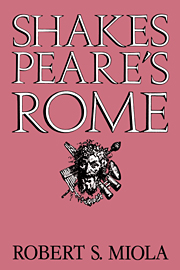Book contents
- Frontmatter
- Contents
- Acknowledgments
- Notes on sources
- I The roads to Rome
- II The Rape of Lucrece: Rome and Romans
- III Titus Andronicus: Rome and the family
- IV Julius Caesar: Rome divided
- V Antony and Cleopatra: Rome and the world
- VI Coriolanus: Rome and the self
- VII Cymbeline: Beyond Rome
- VIII Conclusion
- Index
VI - Coriolanus: Rome and the self
Published online by Cambridge University Press: 28 October 2009
- Frontmatter
- Contents
- Acknowledgments
- Notes on sources
- I The roads to Rome
- II The Rape of Lucrece: Rome and Romans
- III Titus Andronicus: Rome and the family
- IV Julius Caesar: Rome divided
- V Antony and Cleopatra: Rome and the world
- VI Coriolanus: Rome and the self
- VII Cymbeline: Beyond Rome
- VIII Conclusion
- Index
Summary
For all their obvious differences, Coriolanus shares important similarities with Antony and Cleopatra. Alfred Harbage observes that both plays feature a struggle for power that “goes against a naturally superior man because of his failure to accommodate himself to reality.” J. Dover Wilson writes that Coriolanus and Antony “were soldiers, both cast in the heroic mould, both subject to fits of vehement passion which in the end brought them to disaster.” Geoffrey Bullough suggests that Antony and Coriolanus are parallel portraits of concupiscence and irascibility – the Aristotelian complements. Norman Rabkin treats the plays as “opposite halves of the same statement” about the possibilities of heroism and self-fulfillment in this world. Both Antony and Coriolanus suffer in exile from Rome and both die in the tragic attempt to return home. The Romes that these soldiers struggle against, though radically different in political organization, present one and the same paradox: In both plays Rome is a noble place of high heroic deeds and honor, as well as a sordid center of selfish scheming and political infighting.
Despite these similarities, the far-flung empire of Antony and Cleopatra little resembles the constricted and constrictive city in Coriolanus. This urbs, again an image of Troy, is sharply defined by outlying battlefields, rival towns, and its own vividly realized topography – its walls, gates, Capitol, Tiber, Tarpeian rock, forum, private houses, and streets. The action inside Rome, as T. J. B. Spencer notes, is depicted with unusual attention to local color, as if Shakespeare hoped that the precise rendering of concrete detail would yield forth the abstract principles and problems there embodied, as if careful representation of Rome's body would reveal its soul.
- Type
- Chapter
- Information
- Shakespeare's Rome , pp. 164 - 205Publisher: Cambridge University PressPrint publication year: 1983



